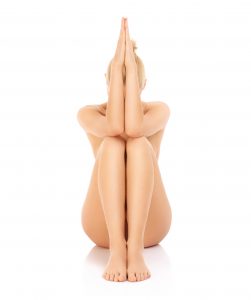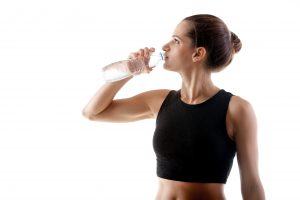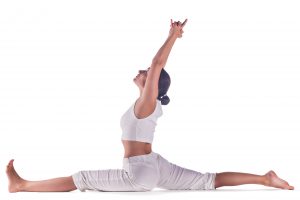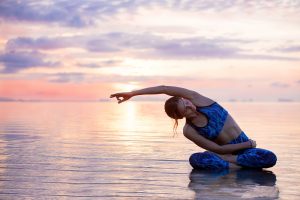 It’s getting hot in here….so take off all your clothes!
It’s getting hot in here….so take off all your clothes!
While I have full respect for the naked yogis out there, I don’t really want my wobbly bits on show when I’m practising even if it is 100 degrees outside.
My practise these days feels different. Ashtanga, Vinyasa, Rocket and Power yoga are not just a challenge but feel practically impossible. My mat needs a daily clean from my sweat and I’m chugging through more water than I ever thought possible….Ah, it must be Summer.
I love pushing myself in my practice, but with the temperature soaring outside even the simplest vinyasas can feel like Mount Everest. It dawned on me during a recent workshop I ran that my students felt it too. A group normally happy to practise as many arm balances and floating vinyasas that 90 minutes would allow, were fatigued half way through the session. Taking it down a notch was very necessary!
So what does one do? In the UK air conditioning isn’t really the standard unless you are in a fancy gym, and while my generous boyfriend bought me a Dyson fan, it’s not the ideal solution. However, there are ways we can change up our practise so we are more comfortable with our yoga practise in the summer months.
Here are my Golden Rules for Summer:
Drink, Drink Drink
A pretty obvious one, but the most important. When we practise in the heat we sweat more which is our body’s way of cooling us down. In turn, we become dehydrated which means our body loses more water than it takes in. I remember when I was practising Bikram yoga on a regular basis, I would always get severe headaches after class because I wasn’t drinking enough fluids.
To combat this, I made sure I drank my minimum 3 litres of water a day (yes we hear it all the time), making sure I was drinking before and after a yoga class.
When we are dehydrated our blood volume decreases which means there is less blood to go to the working muscles. You may want to consider taking Electrolytes but avoid high sugar energy drinks that are packed with sugar and empty calories.
 I would even drink coconut water after an especially sweat-inducing class. My headaches disappeared immediately. Coconut water is excellent for dehydration and contains potassium, magnesium, antioxidants and a number of other benefits making it my go-to drink when I exercise. It also tastes a lot nicer than those god awful salty blackcurrant dehydration sachets. Birch water is also a great option, but it is a little harder to get hold of. In the UK I have only ever seen it in Waitrose and Health Food shops.
I would even drink coconut water after an especially sweat-inducing class. My headaches disappeared immediately. Coconut water is excellent for dehydration and contains potassium, magnesium, antioxidants and a number of other benefits making it my go-to drink when I exercise. It also tastes a lot nicer than those god awful salty blackcurrant dehydration sachets. Birch water is also a great option, but it is a little harder to get hold of. In the UK I have only ever seen it in Waitrose and Health Food shops.
Make sure you don’t wait until you are thirsty to rehydrate. Keep a bottle of water with you at all times and try to avoid alcohol (that’s a tough one) and caffeine. Invest in a Citrus Zinger or something similar to pimp up your water, after all 3 litres a day can get dull quick. Add citrus fruit, cucumber, mint or berries – really the only limitations are your imagination.
Clothing
My first ever yoga class was hardly a fashion parade, more a case for the fashion police, not that that matters but it is funny looking back. Now I am not saying you need to hop down to the nearest sports store and spend a small fortune on figure flattering ‘sexy’ yoga gear (although I love a spree in Lululemon myself), but it is important you wear the right clothing.
Needless to say, my thick, bobbled, saggy sweatpants and t-shirt I got free in some random event goody bag did not cut the mustard for what turned out to be a rather sweaty yoga class.
My clothes clung to me, I felt uncomfortable and quite frankly, gross. My cheap/free kit rode up in places where it shouldn’t and felt kind of heavy the hotter I got. I learnt very quickly that high-performance sportswear made from polyester that draws sweat away from the body was a sensible investment for yoga in the heat. I personally love Nike Dri-Fit, GapFit, Calvin Klein Performance and Adidas Climalite, but of course yoga brands like Lululemon and Alo also have their own range of high performance clothing.

I also tend to wear a sports bra that I can wear without a tank top over the top – so something less ‘underweary’. I like to feel supported, and while I don’t revel in getting my midriff out (was never a fan of crop tops), it’s nice to have the option I can de-layer if the heat gets too much.
Shorts are also an excellent option :) One of my male friends practises in his favourite pair of black running shorts and never wears anything else, even in the colder months (!). The main thing is just make sure you are comfortable and save the long-sleeved tops and hoodies until Autumn.
Slow Down and Listen to Your Body
The main thing here is to use your common sense. Asanas should feel good, you should be able to breathe easily and most of all you should be enjoying yourself. If it starts to feel like you are climbing Mount Fuji, it’s time to take stock and pay more attention to your body and how you feel during your class.
I teach a lot of Vinyasa yoga, often with a focus on core and strength. This can be even more of a challenge in the summer.
Some of the places I teach actually have air-conditioning, but many do not. The glorious sunshine peering into the windows can be beautiful to practise in, but you sure do feel it if your mat happens to be in the sunlight…slipping much?
A solution to a power yoga style class in the heat is to take it down a notch. Whether this is changing your Vinyasa from the traditional: Phalakasana (Plank pose), Chaturanga Dandasana (Four-Limbed Staff Pose), Urdhva Mukha Svanasana (Upward Facing Dog), Ardha Mukha Svanasana (Downward Facing Dog), consider this:
 Bharmanasana (Table Top), Balasana (Child’s Pose), Bhujangasana (Cobra Pose), Balasana (Child’s Pose).
Bharmanasana (Table Top), Balasana (Child’s Pose), Bhujangasana (Cobra Pose), Balasana (Child’s Pose).
Make sure you stay a little longer in Savasana (Corpse pose) at the end of class to give your body time to recuperate. Well, you don’t have to ask me twice! Zzzzzzzzz
You could even skip the Vinyasa and take Balasana (Child’s Pose) – this is an option that is always available to you when the practice gets too much. Anything works as a Vinyasa as long as you link the breath with movement.
The Golden Rule ‘Quality over Quantity’ rings true here. Modify and come down to the knees and use props to create space and go easy on yourself. It is much better to lower to a Chaturanga whilst on your knees than just collapse into the shoulders and the wrists through heat exhaustion.
Focus on Flexibility
 Use the heat to your advantage! I love a strength-focused practice, but sometimes it is just too darn hot.
Use the heat to your advantage! I love a strength-focused practice, but sometimes it is just too darn hot.
On super hot and humid days, consider a practice focused on flexibility or even Yin Yoga.
The heat increases the blood flow into the muscles resulting in more flexibility. Warm muscles mean it is easier to relax in intense stretches thereby increasing your overall flexibility. Add Yin yoga to the mix and that’s some serious fascia massage happening right there.
June and July could be just the right time to start setting goals to get into those stretchy poses on your checklist. There are tonnes of inspirational journey goals on Instagram which helps with your motivation. This could be just the boost you need to start your Hanumanasana (full splits) journey :)
Practise in the Morning or the Evening
 The best time to practise in the summer is before 10am and after 3pm. The sun is at it’s hottest during this time and unless you want a Bikram style practice, it’s better to avoid an afternoon yoga session.
The best time to practise in the summer is before 10am and after 3pm. The sun is at it’s hottest during this time and unless you want a Bikram style practice, it’s better to avoid an afternoon yoga session.
If you are outside for your practice, make sure you wear sunscreen. This might be a case of teaching your Grandmother to suck eggs here, but it is important. A baseball cap is also a great option for keeping the sun off your face, and you will always find me sporting a pair of sunnies :)
Try something different
Summer is a great opportunity to try something different. If you live in a city, rooftop yoga at sunrise can be a lovely way to change up your practice, or even beach yoga if you are lucky enough to live close to the sea.
I recently had a go at SUP yoga. I have lived by the sea for many years but never really considered SUP yoga until I found out a friend of mine was teaching a class just down the road from where I lived.

Of course, this is a style of yoga that is very much weather dependant, but it felt great to try something different. The weather was glorious and being on the ocean on a paddle board was so much fun. If I ever got too hot I could dip my toes into the water and cool off – grand!
Even the simplest of poses turned out to be a humbling experience. Your balance is challenged especially when you take the Drishti out of the equation – EVERYTHING moves. You have to ground your feet and hands a lot, make sure your alignment is as correct as it can be and above all else use that core!
You may fall in, but it’s so cool and lovely you may find yourself doing it deliberately!
The key here, is make the most of the summer and turn the heat into a positive element of your practice rather than something that just leaves you feeling hot and bothered.
Follow these simple rules and you will certainly ‘Beat the Heat’, and if all else fails, make sure your freezer is stocked with ice lollies and ice cream – you deserve it!
Namaste
Vic xox
The information provided on this website is for educational purposes only and in no way represents any form of medical or physical advice. By making use of this content, you are participating at your own risk. You should consult a doctor or physician before attempting any form of exercise or poses to ensure you do not injure yourself as a result. By making use of this website, you agree that Sida Yoga accepts no liability whatsoever for any damages or injuries howsoever caused.

